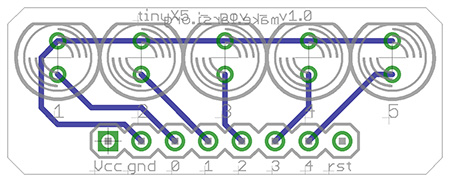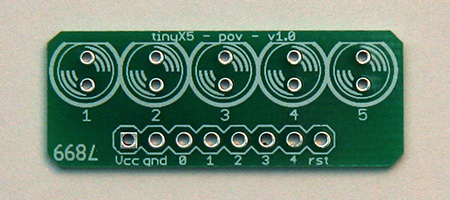ATtinyX5 - pov
Similar to the original MiniPOV - 5 LEDs connected to all the data pins. Great to learn about programming and just debugging of some code.
Parts List
| 5 | LEDs | generic (I used orange, because the 2.0V is great for battery powered projects) |
| 1 | PCB | |
| 1 | board | |
| 1 | bridge |
For red/orange/yellow LEDs and 3.3V use 100Ω ¼W resistors - brownblackbrowngold For red/orange/yellow LEDs and 5.0V use 220Ω ¼W resistors - redredbrowngold |
 |
 |
 |
 |
Code
All the code be downloaded from here.
#include <avr/io.h> // this contains all the IO port definitions
#include <util/delay.h>
#define DELAY 625 // 625ms * 32 = 20 seconds
int main (void) {
DDRB = 0x1F; // output: 0, 1, 2, 3, 4
while (1) {
for (int i = 0; i < 32; i++) {
PORTB = i;
_delay_ms(DELAY);
}
}
return 0;
}
#include <avr/io.h> // this contains all the IO port definitions
#include <util/delay.h>
#define DELAY 125 // 125ms * 8 = 1 seconds
void display(int v) {
PORTB = v;
_delay_ms(DELAY);
}
int main (void) {
DDRB = 0x1F; // output: 0, 1, 2, 3, 4
while (1) {
display(0x01);
display(0x02);
display(0x04);
display(0x08);
display(0x10);
display(0x08);
display(0x04);
display(0x02);
}
return 0;
}